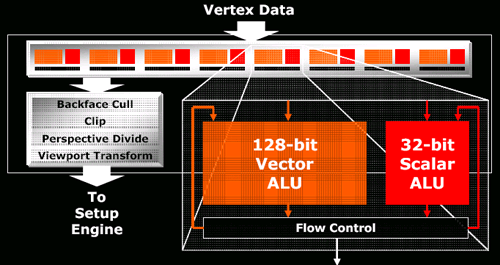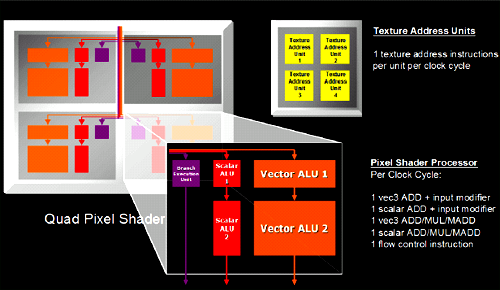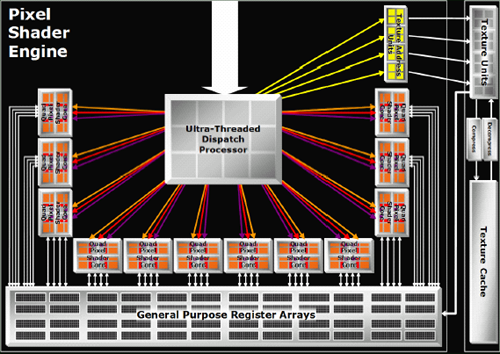ATI's New Leader in Graphics Performance: The Radeon X1900 Series
by Derek Wilson & Josh Venning on January 24, 2006 12:00 PM EST- Posted in
- GPUs
R580 Architecture
The architecture itself is not that different from the R520 series. There are a couple tweaks that found their way into the GPU, but these consist mainly of the same improvements made to the RV515 and RV530 over the R520 due to their longer lead time (the only reason all three parts arrived at nearly the same time was because of a bug that delayed the R520 by a few months). For a quick look at what's under the hood, here's the R520 and R580 vertex pipeline:

and the internals of each pixel quad:

The real feature of interest is the ability to load and filter 4 texture addresses from a single channel texture map. Textures which describe color generally have four components at every location in the texture, and normally the hardware will load an address from a texture map, split the 4 channels and filter them independently. In cases where single channel textures are used (ATI likes to use the example of a shadow map), the R520 will look up the appropriate address and will filter the single channel (letting the hardware's ability to filter 3 other components go to waste). In what ATI calls it's Fetch4 feature, the R580 is capable of loading 3 other adjacent single channel values from the texture and filtering these at the same time. This effectively loads 4 and filters four times the texture data when working with single channel formats. Traditional color textures, or textures describing vector fields (which make use of more than one channel per position in the texture) will not see any performance improvement, but for some soft shadowing algorithms performance increases could be significant.
That's really the big news in feature changes for this part. The actual meat of the R580 comes in something Tim Allen could get behind with a nice series of manly grunts: More power. More power in the form of a 384 million transistor 90nm chip that can push 12 quads (48 pixels) worth of data around at a blisteringly fast 650MHz. Why build something different when you can just triple the hardware?

To be fair, it's not a straight tripling of everything and it works out to look more like 4 X1600 parts than 3 X1800 parts. The proportions work out to match what we see in the current midrange part: all you need for efficient processing of current games is a three to one ratio of pixel pipelines to render backends or texture units. When the X1000 series initially launched, we did look at the X1800 as a part that had as much crammed into it as possible while the X1600 was a little more balanced. Focusing on pixel horsepower makes more efficient use of texture and render units when processing complex and interesting shader programs. If we see more math going on in a shader program than texture loads, we don't need enough hardware to load a texture every single clock cycle for every pixel when we can cue them up and aggregate requests in order to keep available resources busy more consistently. With texture loads required to hide latency (even going to local video memory isn't instantaneous yet), handling the situation is already handled.
Other than keeping the number of texture and render units the same as the X1800 (giving the X1900 the same ratios of math to texture/fill rate power as the X1600), there isn't much else to say about the new design. Yes, they increased the number of registers in proportion to the increase in pixel power. Yes they increased the width of the dispatch unit to compensate for the added load. Unfortunately, ATI declined allowing us to post the HDL code for their shader pipeline citing some ridiculous notion that their intellectual property has value. But we can forgive them for that.
This handy comparison page will have to do for now.
The architecture itself is not that different from the R520 series. There are a couple tweaks that found their way into the GPU, but these consist mainly of the same improvements made to the RV515 and RV530 over the R520 due to their longer lead time (the only reason all three parts arrived at nearly the same time was because of a bug that delayed the R520 by a few months). For a quick look at what's under the hood, here's the R520 and R580 vertex pipeline:

and the internals of each pixel quad:

The real feature of interest is the ability to load and filter 4 texture addresses from a single channel texture map. Textures which describe color generally have four components at every location in the texture, and normally the hardware will load an address from a texture map, split the 4 channels and filter them independently. In cases where single channel textures are used (ATI likes to use the example of a shadow map), the R520 will look up the appropriate address and will filter the single channel (letting the hardware's ability to filter 3 other components go to waste). In what ATI calls it's Fetch4 feature, the R580 is capable of loading 3 other adjacent single channel values from the texture and filtering these at the same time. This effectively loads 4 and filters four times the texture data when working with single channel formats. Traditional color textures, or textures describing vector fields (which make use of more than one channel per position in the texture) will not see any performance improvement, but for some soft shadowing algorithms performance increases could be significant.
That's really the big news in feature changes for this part. The actual meat of the R580 comes in something Tim Allen could get behind with a nice series of manly grunts: More power. More power in the form of a 384 million transistor 90nm chip that can push 12 quads (48 pixels) worth of data around at a blisteringly fast 650MHz. Why build something different when you can just triple the hardware?
To be fair, it's not a straight tripling of everything and it works out to look more like 4 X1600 parts than 3 X1800 parts. The proportions work out to match what we see in the current midrange part: all you need for efficient processing of current games is a three to one ratio of pixel pipelines to render backends or texture units. When the X1000 series initially launched, we did look at the X1800 as a part that had as much crammed into it as possible while the X1600 was a little more balanced. Focusing on pixel horsepower makes more efficient use of texture and render units when processing complex and interesting shader programs. If we see more math going on in a shader program than texture loads, we don't need enough hardware to load a texture every single clock cycle for every pixel when we can cue them up and aggregate requests in order to keep available resources busy more consistently. With texture loads required to hide latency (even going to local video memory isn't instantaneous yet), handling the situation is already handled.
Other than keeping the number of texture and render units the same as the X1800 (giving the X1900 the same ratios of math to texture/fill rate power as the X1600), there isn't much else to say about the new design. Yes, they increased the number of registers in proportion to the increase in pixel power. Yes they increased the width of the dispatch unit to compensate for the added load. Unfortunately, ATI declined allowing us to post the HDL code for their shader pipeline citing some ridiculous notion that their intellectual property has value. But we can forgive them for that.
This handy comparison page will have to do for now.










120 Comments
View All Comments
Josh Venning - Tuesday, January 24, 2006 - link
:-)GTMan - Tuesday, January 24, 2006 - link
How long until we see lower end parts.My guesses:
X1900XL replaces X1800XL
X1700 replaces X1600
Sledgehamer70 - Tuesday, January 24, 2006 - link
Has anyone else noticed that the X1900XTX only out performs over all in the 1920 x 1440 settings? It is a 50/ 50 split for the most part in 1280 x 960 and 1600 x 1200. So once again everyone and there mom wont be seeing the same numbers as these guys! So misleading!Yeah I know its looking ahead to the future, but looking on themarket only 5%-2% of gamers run games at these specs... I will give ATI credit that they made a good card "Finally" but lets compare apples to apples, they should take the combined scores and average them out and see what the overall outcome is... im sure ATI will still ead but by not as much as it portray's!
DerekWilson - Tuesday, January 24, 2006 - link
again, if you want a card to run at low resolutions, the 6800 GS or x800 gto are probably much better and more cost effective ways to go.why does everyone want to swat a fly with a baseball bat?
Wellsoul2 - Tuesday, January 24, 2006 - link
Hmm..1280x1024 would seem to be a useful resolution since many use19 in and 17 in LCD's.
Seriously, No way can I afford this card but I would like to see it
compared to the 1800XL card at this resolution.
(I'm hoping the 1800XL price drops so I can pick up an ATI shader3
card for less than $250 which is my price point)
Yay for ATI..but ATI still has no mid priced card with shader3.0 :-(
beggerking - Tuesday, January 24, 2006 - link
well, the definition of "resolution most people run" change constantly. I understand you are using 4x AA, but 8xAA is right around the corner, as well as higher resolution.I don't see this kind of performance advantage for x1900xtx on any other setting than the one you used for performance advantage, therefore that graphic is perhaps, a personal/biased view that will not stand against time.
vladik007 - Tuesday, January 24, 2006 - link
Are they really out of their mind ? I've never bought console before but these PC components prices are gonna drive me out of the market.And i thought my 6800GT for $400 was absurd price to pay.... wow
nullpointerus - Tuesday, January 24, 2006 - link
I have an idea. Maybe you could buy something less expensive. For example, a $200 card should be able to play modern games albeit with lower image quality than the more expensive cards. But don't tell anyone! I want to keep this a secret.poohbear - Wednesday, January 25, 2006 - link
rofl nullpointerus u crack me up. So true man, LETS keep it a secret.;)poohbear - Wednesday, January 25, 2006 - link
rofl nullpointerus u crack me up. So true man, LETS keep it a secret.;)